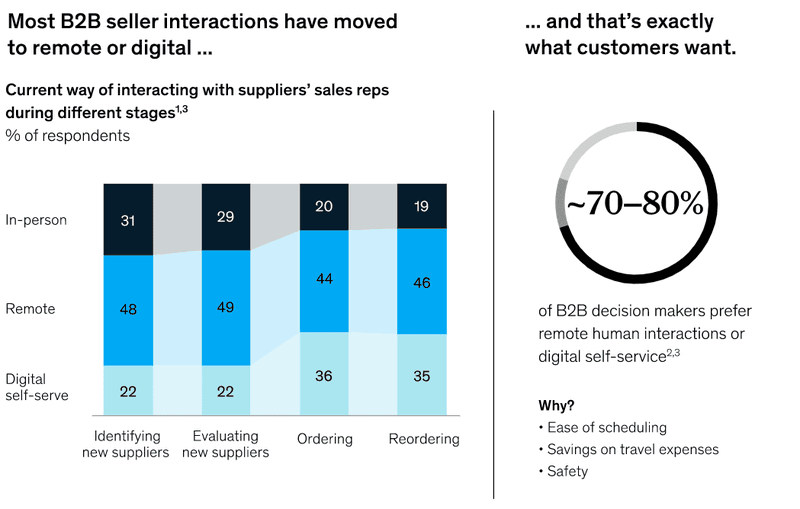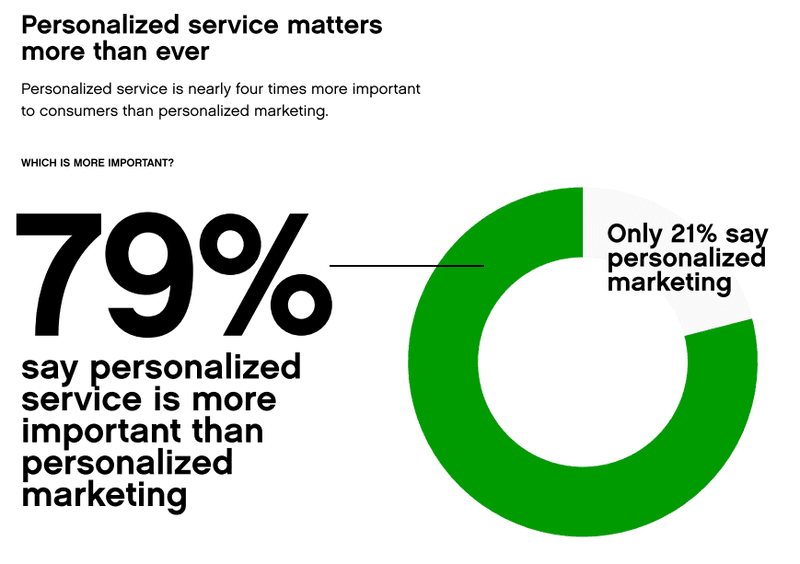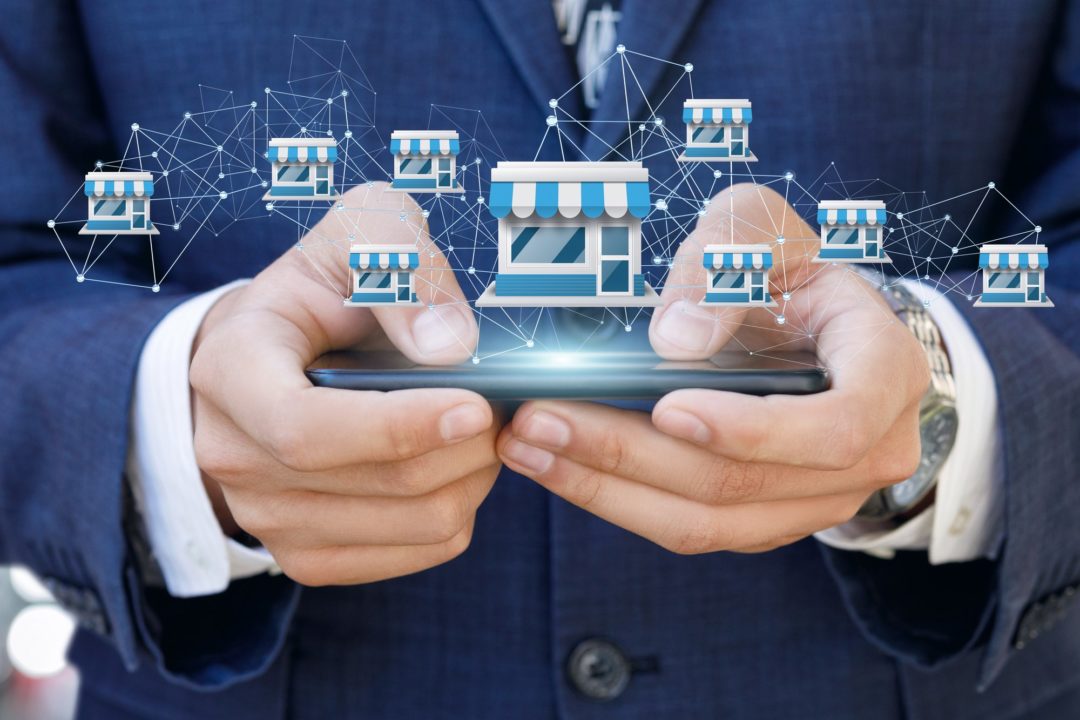The internet and the Covid-19 pandemic have radically transformed the way we do business. Before the COVID-19 pandemic struck, most B2B interactions took place offline. In contrast, B2C operators had already embraced the concept of global and local eCommerce, and with a steady stream of businesses joining the online migration, the B2B industry had to follow suit.
Nearly 50% of all the B2B interactions have now moved online and about 30% of them have become self-serve transactions. On the other hand, only between 20-30% of all interactions now happen in person. This is a dramatic change for an industry that primarily relied on in-person contact.
Gone are the days when marketing was mostly local and sales were restricted to storefronts in your city or town. In this new digital age, businesses have access to customers across the globe through distribution channels like Amazon and eBay, for example.
However, as most B2B businesses are new to the eCommerce space, business owners are scrambling to gain traction and establish a formidable online presence before their competitors do. The reason: many of these companies—especially those who've been in the industry for 10+ years—are entirely new to the world of online sales and thus woefully unprepared for the extremely competitive digital journey.
But all’s not lost. There are ways to leverage local eCommerce sites to expand your sales channels online. This post will explore (a) the benefits of partnering with local retailers through eCommerce channels and (b) best practices for setting up multiple online storefronts.

Advantages of Partnering with Local Retailers Through eCommerce
As a large distributor that needs to quickly reach a vast number of customers in varied areas, it makes sense to partner with local retailers. However, your products, services, and even marketing content need to be very localized to resonate with your target audience.
There are a number of steps you can take to achieve this. Localizing your website content to the local language and providing localized product suggestions, for example. However, to take things to the proverbial next level, it’s crucial to partner with local retailers who have in-depth knowledge of a particular region.
Here’s Why You Must Partner with Local Partners and Leverage Local eCommerce
Enter New Markets Rapidly
One of the biggest advantages of partnering with local retailers to engage in local eCommerce is that it enables you to reach new markets. As a large distributor, you’d have to typically face a series of potential hurdles such as overcoming cultural barriers, for example, when your expansion takes in new markets.
Being an ‘outsider’ means it would take time for potential customers to warm up to your brand and what it offers. However, this wouldn’t be the case if you partner with a local retailer. These partners would know the region and its people well. Consequently, their insights will prove invaluable in determining what it takes to strike resonance with the target customers in a particular locality.
In addition, and importantly, as the retailers would typically belong to these same communities, chances are that potential customers would already be familiar with them. This, in turn, would mean they are already trusted by these potential customers and would thus facilitate easier access to new markets.
Expanding Customer Base
Entering news markets will, of course, expand your customer base. Even as a distributor, there are only so many people that you can reach through your marketing campaigns. In an increasingly globalized world, it’s essential to spread your reach as far as possible.
To appeal to local audiences, your products need to be customized to match local needs. To plan around this, you’ll need to have in-depth knowledge about local trends, traits, and quirks. In such a situation, the role of your eCommerce partners in the form of local retailers can prove extremely useful to smooth your entry into new markets. To reinforce the point in a real-world scenario, FAMILO, a family messaging app, recorded a 400% increase in their customer base when they partnered with local operators to expand their services internationally.
Enhanced Customer Satisfaction
Finding new customers is one thing, but retaining them is a different ball game altogether. This is extremely important considering that retaining customers doesn’t cost as much as it does to acquire new ones.
It’s precisely why the customer service, satisfaction, and experience aspects are extremely important for any brand. Increasingly demanding customers insist on it too. Research shows that 79% of customers believe that personalized service is more important than personalized marketing.

Responsive service, in turn, translates into higher satisfaction rates. Localization helps here too as your business strategy would thus be tailored to resonate with the culture of the location. Partnering with a local retailer can help you achieve this with ease and, as a result, your service would be even more personalized.
The case for partnering with a local entity to set up your eCommerce channels is manifold. However, there are bound to be obstacles.
Challenges of Setting Up Local eCommerce Channels for Retailers
There are many challenges that you might face when setting up your local eCommerce channels. This can hinder your plans and even lead to additional expenses.
Setting Up a Local eCommerce Website Is Expensive
When you embark on your local eCommerce journey, it's essential to help local retailers build dynamic websites. This can be quite an expensive and complex undertaking for your partners. Let’s break down the components associated with building a modern eCommerce website.
- Web Hosting Costs: You’d have to find a web hosting provider to host the website and would have to pay a monthly or yearly fee for the same. You’d also have to purchase a domain name for the website and that adds to the expenses.
- Custom Programming: An eCommerce website requires custom coding and programming. This is necessary to add additional functionality to the site.
- Website Design: You would also need to consider the design of the website itself. This would entail hiring experts to customize it, or even get a custom theme built.
All of these elements cost money and could add up to $800-$2000+ each year. Your local retailers would have to carry these costs and convincing them to do so could prove challenging.
Managing Multiple Local eCommerce Channels Is Expensive
Setting up local eCommerce for retailers can also burn a hole in your pocket. While local retailers would have to shoulder the cost of building the eCommerce website, your responsibilities could include setting up:
- An eCommerce portal through which the customers of the local retailer can see and buy your products.
- A product database that includes all the product catalogs for the retailer.
- A payment gateway through which the local retailer can accept payments and process orders. You’d have to integrate it too.
- Maintaining the eCommerce portal, payment gateway, product catalog, and other features to ensure the smooth functioning of your eCommerce portal.
These expenses could be manageable if you have partnered with a few local retailers. However, these costs can rise significantly if you're engaged in an aggressive expansion plan by partnering with hundreds of local retailers. You would also have to manage multiple websites and take care of a multitude of needs and demands so the managerial functions would also affect your bottom line.
Strategies for Partnering with Local Retailers Using eCommerce Channels
With the right solutions in place, the hurdles to spinning out several local retailer websites are easily overcome. With the SWOT analyses completed, let’s now focus on the best practices for creating local eCommerce channels to drive growth.
Conduct Market Research
For effective marketing and personalization, it’s paramount to understand your target audience first. You need to understand what drives them and what does not to ensure your marketing campaigns find resonance. You might already be tracking user behavior online so you need to dive deeper into this data, analyze it and act on it.
The insights you glean from this market research should determine how you promote your products or services in each location and help you locate customers. Some questions to consider while going about market research include:
- What is popular in the region?
- Which language is most popularly spoken?
- What appeals to the local population?
- When are customers most likely to shop?
- Which channels are your target customers using?
Localize Product Catalog and Content
Localization is an important part of any marketing strategy as it helps your message to resonate better among an intended audience. You need to start localizing your content based on your market research. Develop content in the local language to instantly strike a connection with potential customers.
Currencies and payment preferences should be managed in a way that’s relevant for the people of that location. And offer your website visitors the option to choose their preferred language. Apart from creating a connection with the audience, it would also send a strong message that your brand is a responsive entity in touch and in tune with its customers’ needs.
Localization, though, shouldn’t stop there. Your products, too, need to be localized. To achieve this goal, you can leverage product segmentation based on local target customers. This entails grouping similar products together for customers based on their location. As a result, these targeted products are more likely to resonate with your potential customers in those regions and they may be more inclined to buy them. (Real-world example: if you’re a B2B distributor of footwear, you’ll want to highlight sandals for regions experiencing summertime and fur-lined boots for snowy locales.)
Understand Other Local Factors
Apart from local languages, currencies, and products, you also have to consider a host of other local factors. These include:
- Shipping fees: Would shipping be free? Would such fees be included in the pricing?
- Local laws and regulations: What are the local laws governing eCommerce stores?
- Date formats: Which date format is used in the location?
- Privacy policies: What would be the data privacy policy in the location?
- Customer support channels and timings: Which channels would you support (email, phone, live chat)? Would the timings be fixed or 24/7?
Taking these factors into consideration can ensure the smooth functioning of your eCommerce store when you partner with local retailers.
Zobrist: Your Partner in Creating Local eCommerce Channels
With so many moving parts (payment options, language, currency, etc.) when it comes to different locations, it’s natural to encounter challenges when you’re planning to expand your business through local eCommerce channels.
However, you can avoid these issues if you choose to leverage our B2B eCommerce platform solution. All of your B2B eCommerce needs will be met with our single master site and catalog. For example, you can seamlessly create new "extended websites" on the back-end without having to modify or copy-paste code multiple times.
The master website will automatically populate the entire extended website with text, graphics, images, and other elements so that the retailer doesn’t need to do anything. All you have to do is manage a single website’s code.
The platform works as a common unified interface through which you can create all of these extended websites with ease:
- A single codebase that helps you enhance and maintain your websites. All your changes would seamlessly be applied to all the child websites, saving you valuable time.
- Each extended site can select relevant products from the master catalog and add them to theirs.
- Extended sites would also have separate payment processors integrated into them without the need to go about the process from scratch.
- Detailed analytics of local customers for local retailers.
- Security features.
- Single command center for all the websites.
For instance, Mazda dealers are typically independent entities that sell Mazda vehicles and accessories. The Japanese-based car manufacturer could help these retailers start selling Mazda products online by leveraging our B2B eCommerce platform solution. This way, the company would be able to manage all the websites of the dealers through a single interface. Similarly, the dealers would get access to more customers through their extended website without any added effort.
Start Growing Your Distribution Business Today
Growing your distribution business through local eCommerce channels can be expensive and time-consuming to manage.
Zobrist has been helping enterprise-level companies grow their online sales since 2001 using a single codebase and offering scalable solutions that are easy to implement and use no matter your size or budget. It’s the fastest way to gain a competitive advantage while expanding into new markets.
So stop copy-pasting your code and get in touch today to see how the Zobrist-powered solution can deliver results and grow your distribution business.




